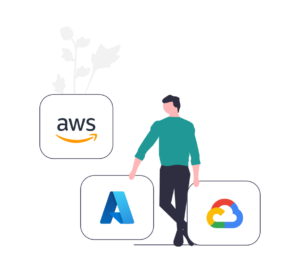Cloud Computing

Cloud computing has transformed the way businesses and individuals access computing resources. By leveraging cloud services, organizations can achieve scalability, flexibility, and cost-effectiveness, without managing physical hardware. We’ll explore the primary cloud computing models—Infrastructure as a Service (IaaS), Platform as a Service (PaaS), and Software as a Service (SaaS)—and highlights common cloud platforms used to deliver these services.
What is Cloud Computing?
It refers to the delivery of computing resources, such as servers, storage, databases, networking, software, and analytics, over the internet (the “cloud”). It allows users to access resources on-demand without having to maintain physical infrastructure. Cloud computing offers several benefits, including scalability, reduced hardware costs, and ease of access from any location.
Cloud Computing Models
Cloud computing is structured into three main models: IaaS, PaaS, and SaaS. Each model provides a different level of abstraction and service, catering to various business needs.
1. Infrastructure as a Service (IaaS)
Infrastructure as a Service (IaaS) provides virtualized hardware resources over the internet, allowing users to build their own IT infrastructure without managing physical hardware. IaaS is the most flexible cloud computing model, offering virtual machines, storage, networking, and other foundational components.
Features of IaaS
- Virtual Machines: Users can create and manage virtual machines to run operating systems and applications.
- Storage and Networking: IaaS offers scalable storage and networking resources, allowing users to configure their infrastructure as needed.
- Self-Service Provisioning: Users can provision and manage resources on-demand, enabling rapid scalability.
Common Use Cases
- Hosting Websites and Applications: IaaS provides the infrastructure needed to host websites, web applications, and other online services.
- Data Backup and Disaster Recovery: IaaS can be used for off-site data storage and disaster recovery solutions.
- Development and Testing Environments: IaaS allows developers to create isolated environments for software development and testing.
Examples of IaaS Platforms
- Amazon Web Services (AWS): Offers a wide range of IaaS services, including Amazon EC2 (Elastic Compute Cloud), Amazon S3 (Simple Storage Service), and Amazon VPC (Virtual Private Cloud).
- Microsoft Azure: Provides IaaS services like Azure Virtual Machines, Azure Blob Storage, and Azure Virtual Networks.
- Google Cloud Platform (GCP): Offers IaaS services such as Google Compute Engine, Google Cloud Storage, and Google Virtual Private Cloud.
If you are reading this, then why not read some more relevant articles given below?
2. Platform as a Service (PaaS)
Platform as a Service (PaaS) provides a platform for developing, deploying, and managing applications without dealing with underlying infrastructure. PaaS offers a higher level of abstraction, allowing developers to focus on building software rather than managing hardware resources.
Features of PaaS
- Development Tools and Frameworks: PaaS provides integrated development environments (IDEs), programming frameworks, and other tools for software development.
- Application Hosting and Deployment: PaaS allows users to deploy applications without managing servers or networks.
- Automatic Scaling and Load Balancing: PaaS platforms automatically scale resources and balance traffic to meet demand.
Common Use Cases
- Web Application Development: PaaS is ideal for developing and deploying web applications without managing underlying infrastructure.
- API Development: PaaS platforms provide tools for building and hosting APIs.
- Database Management: PaaS offers managed databases, allowing users to focus on data rather than infrastructure.
Examples of PaaS Platforms
- Google App Engine: A PaaS platform for building and hosting scalable web applications on Google’s infrastructure.
- Microsoft Azure App Service: Provides a platform for developing and deploying web applications and APIs.
- Heroku: A PaaS platform for building, deploying, and scaling applications, supporting multiple programming languages.
3. Software as a Service (SaaS)
Software as a Service (SaaS) delivers software applications over the internet, allowing users to access and use software without installation or maintenance. SaaS is the most abstract cloud computing model, providing fully managed software services to end-users.
Features of SaaS
- Hosted Applications: SaaS applications are hosted in the cloud and accessed through a web browser or client application.
- Subscription-Based Model: SaaS typically operates on a subscription basis, with users paying for access to the software.
- Automatic Updates and Maintenance: SaaS providers handle software updates and maintenance, reducing the burden on end-users.
Common Use Cases
- Business Productivity Tools: SaaS provides productivity software like word processors, spreadsheets, and presentation tools.
- Customer Relationship Management (CRM): SaaS offers CRM platforms for managing customer interactions and sales processes.
- Collaboration and Communication: SaaS enables team collaboration through platforms for video conferencing, project management, and file sharing.
Examples of SaaS Platforms
- Google Workspace (formerly G Suite): A collection of SaaS productivity tools, including Gmail, Google Drive, and Google Docs.
- Microsoft Office 365: A suite of SaaS applications for productivity, communication, and collaboration, including Outlook, OneDrive, and Teams.
- Salesforce: A leading SaaS platform for customer relationship management (CRM) and sales automation.